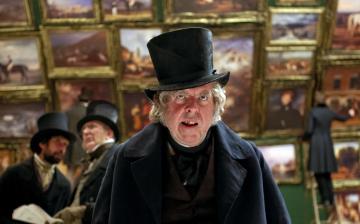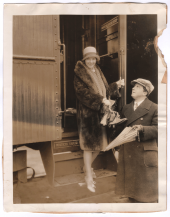'Mr. Turner' delivers superb acting, filmmaking
By Barry Paris / Pittsburgh Post-Gazette
Revolutionary artists rarely have an easy time of it, and rarely give those around them an easy time, while typically reveling in the turmoil they cause. I’ve thought about Beethoven and Picasso in that regard. But I’m now thinking about J.M.W. Turner, and so will you if you treat yourself to Mike Leigh’s stunningly beautiful biopic, “Mr. Turner.”
Timothy Spall occupies — no, devours — the title role of that visionary British painter (1775-1851), whose eccentric personality and wildly original landscapes and seascapes captivated early Victorians.
He has a lower lip on which eagles could perch.
He straps himself to a ship’s mast in a storm so he can later paint the full power and violence of nature.
Being financially secure, he visits aristocrats or brothels, depending on his mood.
He lives with his doting barber-father and studio assistant William Turner Sr. — aka “Daddy,” sweetly played by Paul Jesson — for the bulk of both their lives.
All the while, he is watched over by his fanatically devoted housekeeper Hannah (Dorothy Atkinson), who lurks around corners and silently attends to his every need — sex included — with nary a nod or thank-you for her efforts. To complicate things, Hannah’s aunt (Ruth Sheen) periodically shows up in a quivering rage: She’s the mother of Turner’s two illegitimate daughters, whose existence he denies.
The artist was, in fact, stimulated by everybody and everything. There’s a wonderfully funny scene in which he discovers — and poses for — a daguerreotype photo. Other fine sequences involve his skirmishes with the pitiful artist Benjamin Robert Haydon (Martin Savage), an eventual suicide; with foppish critic John Ruskin; and with his hated rival John Constable.
But the film’s best moments depict his chaotic painting techniques — spitting, battering, attacking, violating the canvases, creating fiery sunsets in “proto-psychedelic” pigments — many of which have since faded. He elevated landscape painting from insipid to profound and, as Romanticism’s precursor to Impressionism, had a huge impact on the later likes of Monet. By the end of his life, his paintings became astonishingly abstract.
Director-screenwriter Mr. Leigh’s past work includes the gorgeous Gilbert & Sullivan biopic “Topsy-Turvy” (1999) and the powerful “Vera Drake” (2004). All of his films are characterized by impeccable attention to detail, in production and set and costume design. His scripts defy traditional structure, exploring idiosyncrasies rather than building to stock climaxes. Here, as ever, Mr. Leigh deals with big human-artistic issues via small, extraordinary moments.
Befitting the subject, Dick Pope’s sumptuous cinematography is on a David Lean epic level, matching the Turner canvases whose creation it illuminates, from the first exquisite opening shot of a Dutch windmill, with two girls’ bodies and voices slowly fading in, as Turner paints. Mr. Pope somehow bridges the gap between painting and photography in the light, texture and composition of every frame — “the sun at crepuscular time of day,” as Turner says, or the special light at Margate.
That photography has earned an Oscar nomination — as have Gary Yershon’s excellent musical score and the production and costume designs. But why not the acting?
Mr. Spall’s performance is nothing short of colossal — with his piercing stare and that terrifying lower lip! Grunting, growling, snorting, stomping through the film with periodic emotional explosions — it’s a scenery-chewing tour de force, perfectly leavened by vulnerability. At times, his Turner looks and sounds almost like Quasimodo. It’s a role he was born to play and, at director Leigh’s request, he spent two years learning how to paint in preparation for it.
Ms. Atkinson nearly steals the show as poor Hannah, long-suffering — literally — from a terrible, scrofulous skin disease that made her life physically as well as psychologically agonizing. Marion Bailey as the charming seaside landlady with whom Turner falls in love is a complementary joy.
Mr. Leigh deserves special kudos for all the wonderful interplay, subtexts and sexual tensions going on among minor characters — people on boats, bored audience members at lectures, “extras” we’ll never see more than once — who are always reacting to the larger action. That helps the inordinate 2½-hour running time of “Mr. Turner” seem to go by in a flash.
And “Mr. Turner,” by the way, has helped generate a new interest in Turner's works: His “Rome, From Mount Aventine” (1835) recently sold at Sotheby’s auction for $47 million — the record for a British artist.
These words from Marcel Proust are supremely relevant to Turner:
“Everything great in our world comes from neurotics. They alone have founded our religions and composed our masterpieces. Never will the world know all it owes to them nor all that they have suffered to enrich us. We enjoy lovely music, beautiful paintings, a thousand intellectual delicacies, but we have no idea of their cost, to those who invented them, in sleepless nights, tears, spasmodic laughter, rashes, asthmas, epilepsies, and the fear of death, which is worse than all the rest.”
Post-Gazette film critic emeritus Barry Paris: parispg48@aol.com.





